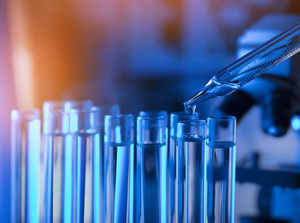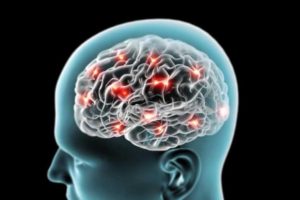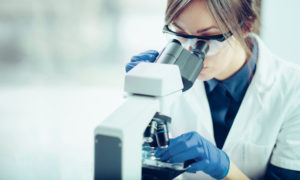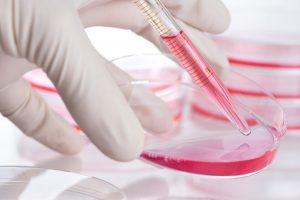Amyotrophic Lateral Sclerosis Specimens
Bay Biosciences provides high quality, clinical grade bio-samples, cryogenically preserved biopsy FFPE tissue blocks, sera (serum), plasma and peripheral blood mononuclear cells (PBMC) biofluid specimens from patients diagnosed with Amyotrophic Lateral Sclerosis (ALS) disease.
The sera (serum), plasma and PBMC biofluid samples are processed from patient’s peripheral whole-blood using customized processing protocols. The Amyotrophic Lateral Sclerosis (ALS) bio-specimens are collected from unique patients suffering from Amyotrophic Lateral Sclerosis (ALS) disease and are provided to a valued pharmaceutical customer for research, development and drug discovery.

Amyotrophic Lateral Sclerosis (ALS) Disease Overview
Amyotrophic Lateral Sclerosis (ALS) is a progressive nervous system disease that affects nerve cells in the brain and spinal cord, causing loss of muscle control. Amyotrophic Lateral Sclerosis (ALS) is also known as Lou Gehrig’s disease or motor neuron disease, is a progressive, degenerative disease that destroys the nerve cells that control voluntary muscle movement. These cells, called “motor neurons,” run from the brain through the brainstem or spinal cord to muscles that control movement in the arms, legs, chest, throat and mouth. In people with ALS, these cells die off, causing the muscle tissues to waste away. ALS does not affect a person’s sensory functions or mental faculties. Other, nonmotor neurons, such as sensory neurons that bring information from sense organs to the brain, remain healthy.
Amyotrophic Lateral Sclerosis (ALS) is a group of rare neurological diseases that mainly involve the nerve cells (neurons) responsible for controlling voluntary muscle movement. Voluntary muscles produce movements like chewing, walking, and talking. The disease is progressive, meaning the symptoms get worse over time. Currently, there is no cure for ALS and no effective treatment to halt, or reverse, the progression of the disease. ALS belongs to a wider group of disorders known as motor neuron diseases, which are caused by gradual deterioration (degeneration) and death of motor neurons. Motor neurons are nerve cells that extend from the brain to the spinal cord and to muscles throughout the body. These motor neurons initiate and provide vital communication links between the brain and the voluntary muscles.
Messages from motor neurons in the brain (called upper motor neurons) are transmitted to motor neurons in the spinal cord and to motor nuclei of brain (called lower motor neurons) and from the spinal cord and motor nuclei of brain to a particular muscle or muscles. In ALS, both the upper motor neurons and the lower motor neurons degenerate or die, and stop sending messages to the muscles. Unable to function, the muscles gradually weaken, start to twitch (called fasciculations), and waste away (atrophy). Eventually, the brain loses its ability to initiate and control voluntary movements.
Early symptoms of ALS usually include muscle weakness or stiffness. Gradually all muscles under voluntary control are affected, and individuals lose their strength and the ability to speak, eat, move, and even breathe. Most people with ALS die from respiratory failure, usually within 3 to 5 years from when the symptoms first appear. However, about 10 percent of people with ALS survive for 10 or more years.

Types of Amyotrophic Lateral Sclerosis (ALS)
Amyotrophic Lateral Sclerosis (ALS) can affects anyone including men and women, the risk increases with age. Following are the two types of Amyotrophic Lateral Sclerosis (ALS):
– Sporadic ALS: Sporadic ALS is the most common form of the Amyotrophic Lateral Sclerosis (ALS) disease in the U.S., accounts for 90 to 95 percent of all cases.
– Familial ALS: Familial ALS (FALS) which is an inherited disorder and accounts for 5 to 10 percent of all cases in the United States. In the families with FALS, there is a 50% chance each offspring will inherit the gene mutation and may develop the disease.
Amyotrophic Lateral Sclerosis (ALS) Disease Symptoms
Signs and symptoms of Amyotrophic Lateral Sclerosis (ALS) vary greatly from person to person, depending on which neurons are affected. Signs and symptoms might include:
- Difficulty walking or doing normal daily activities
- Tripping and falling
- Weakness in your leg, feet or ankles
- Hand weakness or clumsiness
- Slurred speech or trouble swallowing
- Muscle cramps and twitching in your arms, shoulders and tongue
- Inappropriate crying, laughing or yawning
- Cognitive and behavioral changes
Amyotrophic Lateral Sclerosis (ALS) often starts in the hands, feet or limbs, and then spreads to other parts of the body. As the disease advances and nerve cells are destroyed, muscles get weaker. This eventually affects chewing, swallowing, speaking and breathing. There’s generally no pain in the early stages of Amyotrophic Lateral Sclerosis (ALS), and pain is uncommon in the later stages. ALS doesn’t usually affect the bladder control or the senses.

Amyotrophic Lateral Sclerosis (ALS) Disease Causes
Amyotrophic Lateral Sclerosis (ALS) disease affects the nerve cells that control voluntary muscle movements such as walking and talking (motor neurons). Amyotrophic Lateral Sclerosis (ALS) causes the motor neurons to gradually deteriorate, and then die. Motor neurons extend from the brain to the spinal cord to muscles throughout the body. When motor neurons are damaged, they stop sending messages to the muscles, so the muscles can’t function. Amyotrophic Lateral Sclerosis (ALS) disease is inherited in 5% to 10% of patients, for the rest, the cause is unknown. Most theories center on a complex interaction between genetic and environmental factors.
Amyotrophic Lateral Sclerosis (ALS) Risk Factors
Established risk factors for Amyotrophic Lateral Sclerosis (ALS) include:
- Heredity- Five to ten percent of the patients with Amyotrophic Lateral Sclerosis (ALS) inherited it (familial ALS). In most people with familial ALS, their children have a fifty percent chance of developing the disease.
- Age- Amyotrophic Lateral Sclerosis (ALS) disease risk increases with age, and is most common between the ages of 40 and the mid-60s.
- Sex- Before the age of 65, slightly more male patients than female patients develop Amyotrophic Lateral Sclerosis (ALS) disease, this sex difference disappears after age 70.
- Genetics- Some studies examining the entire human genome found many similarities in the genetic variations of people with familial ALS and some people with non-inherited ALS. These genetic variations might make people more susceptible to ALS
Environmental factors, such as the following, might trigger Amyotrophic Lateral Sclerosis (ALS).
- Smoking- Smoking is the only likely environmental risk factor for developing Amyotrophic Lateral Sclerosis (ALS). The risk seems to be greatest for women patients, particularly after menopause.
- Environmental Toxin Exposure- Some evidence suggests that exposure to lead or other substances in the workplace or at home might be linked to Amyotrophic Lateral Sclerosis (ALS). Much study has been done, but no single agent or chemical has been consistently associated with Amyotrophic Lateral Sclerosis (ALS).
- Military service- Studies indicate that people who have served in the military are at higher risk of developing Amyotrophic Lateral Sclerosis (ALS) disease. It’s unclear what about military service might trigger the development of Amyotrophic Lateral Sclerosis (ALS) disease. It might include exposure to certain metals or toxic chemicals, traumatic injuries, viral infections, and intense exertion.

Amyotrophic Lateral Sclerosis (ALS) Complications
As the disease progresses, Amyotrophic Lateral Sclerosis ALS causes complications, such as:
Breathing Problems
Over time, Amyotrophic Lateral Sclerosis (ALS) disease paralyzes the muscles used to breathe. Patient might need a device to help breathe at night, similar to what someone with sleep apnea might wear. For example, patients may be given continuous positive airway pressure (CPAP) or bilevel positive airway pressure (BiPAP) to assist with breathing at night.
Some patients with advanced Amyotrophic Lateral Sclerosis (ALS) disease choose to have a tracheostomy procedure, a surgically created hole at the front of the neck leading to the windpipe (trachea) for full-time use of a respirator that inflates and deflates their lungs. The most common cause of death for patients with Amyotrophic Lateral Sclerosis (ALS) disease is respiratory failure. On average, death occurs within three to five years after symptoms begin. However, some patients with Amyotrophic Lateral Sclerosis (ALS) disease live 10 or more years.
Speaking Problems
Most patients with Amyotrophic Lateral Sclerosis (ALS) disease develop trouble speaking. This usually starts as occasional, mild slurring of words, but becomes more severe. Speech eventually becomes difficult for others to understand, and people with Amyotrophic Lateral Sclerosis (ALS) disease often rely on other communication technologies to communicate.
Eating Problems
Patients with Amyotrophic Lateral Sclerosis (ALS) disease can develop malnutrition and dehydration from damage to the muscles that control swallowing. They are also at higher risk of getting food, liquids or saliva into the lungs, which can cause pneumonia. A feeding tube can reduce these risks and ensure proper hydration and nutrition.
Dementia
Some patients with Amyotrophic Lateral Sclerosis (ALS) disease have problems with memory and decision-making, and some are eventually diagnosed with a form of dementia called Frontotemporal Dementia.

Detailed clinical data, EMG, MRI scan, Spinal tap (lumbar puncture), spinal fluid tests, muscle biopsy, elevated biomarker levels, genetic and metabolic information, pathology annotations associated with the Amyotrophic Lateral Sclerosis (ALS) patient’s specimens is provided to a valued customer for research, development and drug discovery. The Amyotrophic Lateral Sclerosis (ALS) disease sera (serum), plasma and PBMC biofluid samples are processed from patients peripheral whole-blood using customized processing protocols provided by the researcher.
Bay Biosciences is a global leader in providing researchers with high quality, clinical grade, fully characterized human tissue samples, bio-specimens and human bio-fluid collections from cancer (tumor) tissue, cancer sera (serum), cancer plasma, cancer PBMC and human tissue samples from most other therapeutic areas and diseases.
Bay Biosciences maintains and manages it’s own bio-repository, human tissue bank (biobank) consisting of thousands of diseased samples (specimens) and from normal healthy donors available in all formats and types. Our biobank procures and stores fully consented, deidentified and institutional review boards (IRB) approved human tissue samples and matched controls.
All our human human tissue collections, human specimens and human bio-fluids are provided with detailed samples associated patient’s clinical data. This critical patient’s clinical data includes information relating to their past and current disease, treatment history, lifestyle choices, biomarkers and genetic information. Patient’s data is extremely valuable for researchers and is used to help identify new effective treatments (drug discovery & development) in oncology, other therapeutic areas and diseases. This clinical information is critical to demonstrate their impact, monitor the safety of medicines, testing & diagnostics, and generate new knowledge about the causes of disease and illness.
Bay Biosciences banks wide variety of human tissue samples and biological samples including cryogenically preserved -80°C, fresh, fresh frozen tissue samples, tumor tissue samples, FFPE’s, tissue slides, with matching human bio-fluids, whole blood and blood derived products such as serum, plasma and PBMC’s.
Bay Biosciences is a global leader in collecting and providing human tissue samples according to the researchers specified requirements and customized, tailor made collection protocols. Please contact us anytime to discuss your special research projects and customized human tissue sample requirements.
Bay Biosciences provides human tissue samples (human specimens) from diseased and normal healthy donors; including peripheral whole-blood, amniotic fluid, bronchoalveolar lavage fluid (BAL), sputum, pleural effusion, cerebrospinal fluid (CSF), serum (sera), plasma, peripheral blood mononuclear cells (PBMC’s), saliva, Buffy coat, urine, stool samples, aqueous humor, vitreous humor, kidney stones, renal calculi, nephrolithiasis, urolithiasis and other bodily fluids from most diseases including cancer. We can also procure most human bio-specimens and can do special collections and requests of human samples that are difficult to find. All our human tissue samples are procured through IRB approved clinical protocols and procedures.
In addition to the standard processing protocols Bay Biosciences can also provide human plasma, serum, PBMC bio-fluid samples using custom processing protocols, you can buy donor specific sample collections in higher volumes and specified sample aliquoting from us. Bay Biosciences also provides human samples from normal healthy donors, volunteers, for controls and clinical research, contact us Now.
日本のお客様は、ベイバイオサイエンスジャパンBay Biosciences Japan またはhttp://baybiosciences-jp.com/contact/までご連絡ください。


